ANIMALS
25 Birds That Migrate For Winter
Published
7 months agoon

Shutterstock
Bird migration is one of nature’s most remarkable phenomena, showcasing the incredible endurance and navigational skills of these avian travelers. Each year, millions of birds embark on epic journeys, traversing continents and oceans to reach their wintering grounds. This list highlights 25 species known for their spectacular migratory patterns, ranging from tiny hummingbirds to majestic cranes. These migrations not only ensure their survival but also offer breathtaking spectacles for bird watchers and nature enthusiasts. Discover the fascinating stories behind each of these migratory birds and their extraordinary seasonal voyages.
Arctic Tern
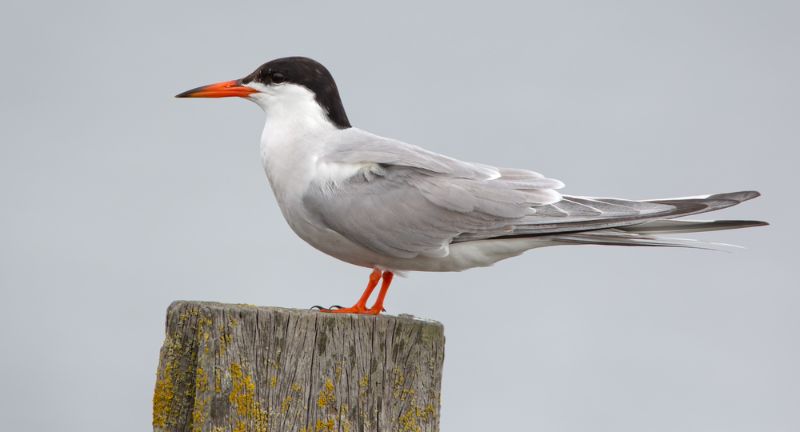
Shutterstock
The Arctic Tern is famous for having the longest migration of any bird species. It travels from its breeding grounds in the Arctic to the Antarctic and back each year. This incredible journey can be up to 25,000 miles round trip. These birds rely on a variety of marine environments for feeding during their migration.
Barn Swallow

Shutterstock
Barn Swallows are small, agile birds known for their graceful flight. They migrate from North America to Central and South America for the winter. Their diet consists mainly of insects, which they catch in flight. During migration, they travel in flocks and can cover large distances each day.
Blackpoll Warbler

Shutterstock
The Blackpoll Warbler is known for its extraordinary long-distance migration. This small songbird travels from its breeding grounds in North America to South America for the winter. Remarkably, it can fly non-stop over the Atlantic Ocean for up to 72 hours. Its journey is one of the most impressive among small migratory birds.
Canada Goose
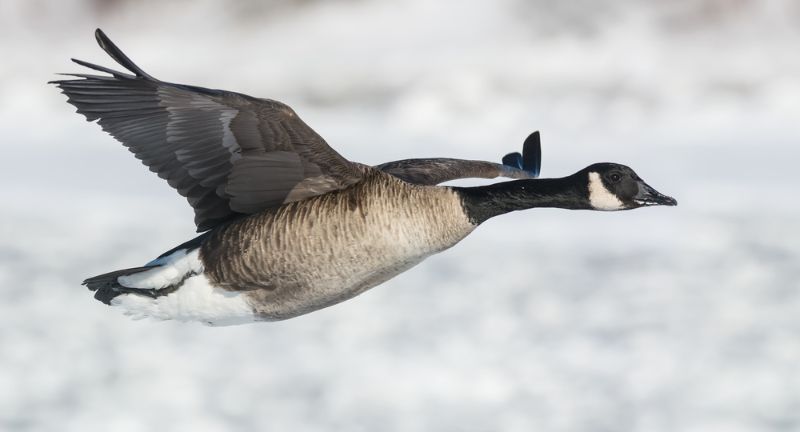
Shutterstock
Canada Geese are well-known for their distinctive V-formation during migration. They travel from Canada and the northern United States to more temperate areas in the United States and Mexico. Their migration is prompted by the search for open water and food. These geese are often seen in large flocks during their migration periods.
Common Crane
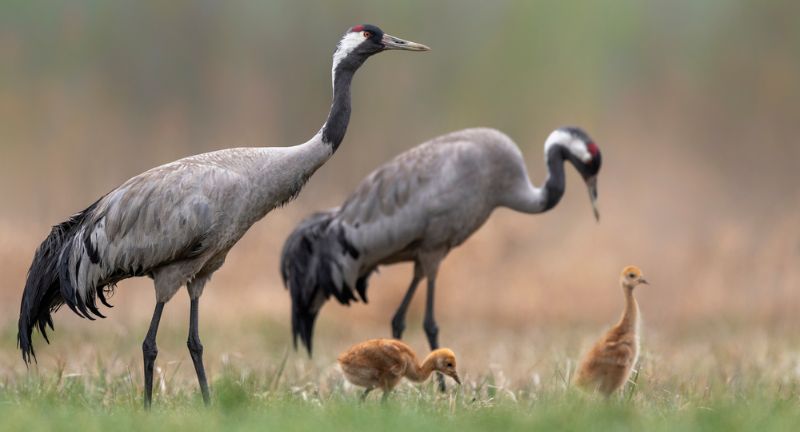
Shutterstock
The Common Crane undertakes long migrations from Europe and Asia to North Africa and parts of southern Asia. These large, majestic birds travel in flocks and use thermal currents to glide effortlessly over long distances. They are known for their loud, trumpeting calls which can be heard during migration. Conservation efforts have helped stabilize their populations in recent years.
Dark-eyed Junco

Shutterstock
Dark-eyed Juncos are small, sparrow-like birds that migrate from northern Canada to the United States during winter. They are often seen in flocks, foraging on the ground for seeds. Their distinctive dark eyes and slate-colored feathers make them easily recognizable. During migration, they can adapt to various habitats, including forests, fields, and gardens.
Eastern Kingbird
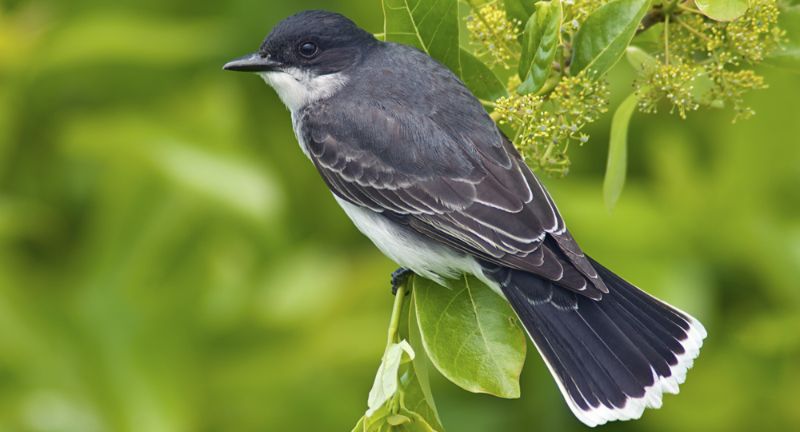
Shutterstock
Eastern Kingbirds migrate from North America to South America for the winter. These birds are known for their aggressive behavior in defending their territory. They feed primarily on insects, which they catch in flight. During migration, they travel in large flocks and can be seen along various flyways.
European Starling

Shutterstock
European Starlings are highly adaptable birds that migrate within Europe and to North Africa for the winter. They are known for their iridescent plumage and ability to mimic sounds. These starlings form large flocks, known as murmurations, which create stunning aerial displays. Their diet consists of insects, fruits, and seeds.
Golden Eagle
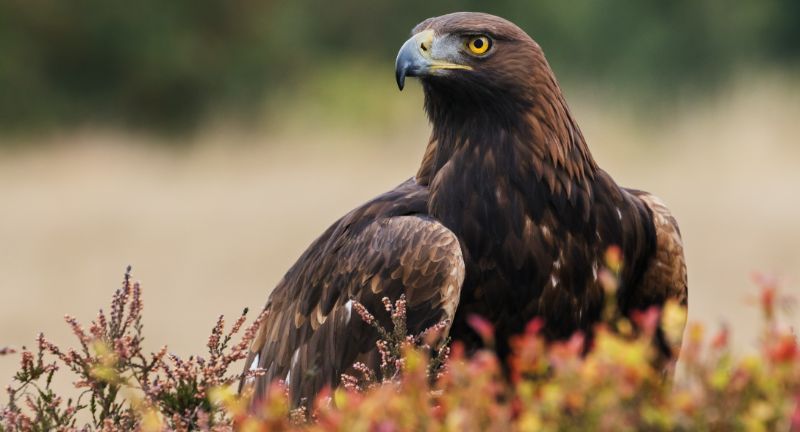
Shutterstock
Golden Eagles are powerful raptors that migrate from northern North America to more temperate regions. They are known for their keen eyesight and hunting prowess. During migration, they rely on thermal currents to cover long distances with minimal effort. These eagles primarily hunt small mammals, birds, and carrion.
Great Blue Heron

Shutterstock
The Great Blue Heron is a large wading bird that migrates from North America to Central and South America. It is known for its striking blue-gray plumage and slow, deliberate movements. These herons feed on fish, amphibians, and small mammals. They are often seen near wetlands, rivers, and coastal areas during migration.
Hummingbird (various species)

Shutterstock
Hummingbirds are tiny, vibrant birds known for their rapid wing beats and hovering flight. Many species migrate from North America to Central and South America. Their migration is fueled by a diet rich in nectar and small insects. Despite their small size, hummingbirds can travel impressive distances during their migration.
Least Sandpiper

Shutterstock
The Least Sandpiper is the smallest shorebird in the world. It migrates from the Arctic tundra to Central and South America for the winter. These birds feed on small invertebrates found in mudflats and marshes. During migration, they travel in flocks and make stopovers at key wetland habitats.
Mallard Duck

Shutterstock
Mallard Ducks are one of the most recognized and widespread waterfowl species. They migrate from northern regions to southern areas during winter. These ducks are highly adaptable and can be found in a variety of habitats, including lakes, rivers, and wetlands. Their diet consists of aquatic plants, insects, and small fish.
Northern Harrier

Shutterstock
Northern Harriers are distinctive raptors known for their low, gliding flight over open fields. They migrate from northern North America to the southern United States and Central America for the winter. These birds hunt small mammals and birds by flying low and surprising their prey. Their owl-like facial disc helps them detect sound, aiding in their hunting.
Osprey

Shutterstock
Ospreys are large raptors that primarily feed on fish. They migrate from North America to Central and South America for the winter. Known for their dramatic dives to catch fish, they are often seen near bodies of water. During migration, they travel alone or in loose groups, covering long distances between breeding and wintering grounds.
Peregrine Falcon
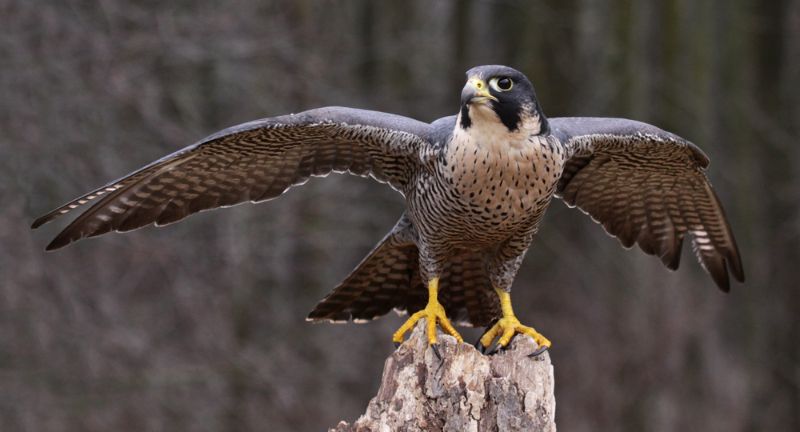
Shutterstock
The Peregrine Falcon is renowned for its incredible speed, making it the fastest bird in the world. These falcons migrate from the Arctic tundra to South America. They are skilled hunters, preying on birds in mid-air with their powerful talons. During migration, they travel along coastlines, mountain ranges, and other major flyways.
Purple Martin

Shutterstock
Purple Martins are the largest swallows in North America. They migrate from North America to South America for the winter. Known for their aerial acrobatics, they catch insects in flight. During migration, they gather in large roosts and can be seen in huge flocks, often roosting in urban areas.
Red Knot

Shutterstock
Red Knots are medium-sized shorebirds known for their long migrations from the Arctic to South America. They rely on key stopover sites to refuel during their journey. These birds feed on small invertebrates found in coastal mudflats and estuaries. Their migration is one of the longest and most arduous among shorebirds.
Ruby-throated Hummingbird

Shutterstock
The Ruby-throated Hummingbird is the only species of hummingbird that breeds in eastern North America. It migrates to Central America for the winter, crossing the Gulf of Mexico in a single, non-stop flight. These tiny birds are known for their iridescent green feathers and rapid wing beats. They feed on nectar and small insects, using their long beaks to access flowers.
Sandhill Crane

Shutterstock
Sandhill Cranes are large, elegant birds that migrate from North America to the southern United States and Mexico. They are known for their graceful courtship dances and trumpeting calls. These cranes feed on a variety of foods, including grains, small mammals, and insects. During migration, they travel in flocks and use thermal currents to aid their long flights.
Snow Goose

Shutterstock
Snow Geese migrate from their breeding grounds in the Arctic to the southern United States and Mexico for the winter. They travel in large flocks, often forming a distinctive V-formation. These geese feed on grasses, grains, and aquatic plants. Their migration is one of the most spectacular avian phenomena, with thousands of birds moving together.
Swainson’s Thrush

Shutterstock
Swainson’s Thrush is a small songbird that migrates from North America to South America for the winter. It is known for its beautiful, flute-like song. These thrushes feed on insects and fruits, foraging in dense vegetation. During migration, they travel at night and use the stars to navigate.
Tree Swallow

Shutterstock
Tree Swallows are small, sleek birds with iridescent blue-green upperparts. They migrate from North America to Central and South America for the winter. These swallows feed on flying insects, often catching them on the wing. During migration, they form large flocks and can be seen roosting in reed beds and other wetland areas.
Wilson’s Warbler

Shutterstock
Wilson’s Warbler is a small, bright yellow bird with a distinctive black cap. It migrates from North America to Central America for the winter. These warblers feed on insects and spiders, foraging in low vegetation. During migration, they travel along major flyways and can be seen in various habitats, including forests and gardens.
Yellow Warbler

Shutterstock
The Yellow Warbler is a small, brightly colored bird that migrates from North America to Central and South America. Known for its cheerful song, it inhabits a variety of habitats, including wetlands and forests. These warblers feed on insects and caterpillars. During migration, they travel in mixed-species flocks, often along river valleys and coastlines.
Conclusion

Shutterstock
The journeys of these migratory birds are truly awe-inspiring, reflecting the resilience and adaptability of nature. Their annual migrations are not just survival strategies but also vital components of global ecosystems. By understanding and appreciating these migrations, we can better protect these species and the habitats they depend on. Observing their migrations also offers a unique connection to the natural world, reminding us of the intricate balance of life on Earth. As you reflect on the incredible voyages of these birds, may you be inspired to support conservation efforts that ensure their continued survival and success.
More Amazing Animals+
-


Love is in the air: Chihuahuas Peanut and Cashew get…
-


Kibble Goes Refillable: Pet Food Company Cracks Down On Waste…
-


Chandler, Arizona Police Officer Helps Duck and Her Ducklings Cross…
-


27 Adorable Forest Creatures That Will Steal Your Heart
-


More – Alligator arrest outside of a school in Charleston,…
-


Lovely Ladybugs: 26 Fascinating Facts About The Cutest Bugs
-


Mama bird feeding her babies in their traffic light nest…
-


25 Animals That Survive Better In The Colder Weather
-


29 Caterpillars That Look More Like Fuzzy Aliens Than Animals
-


Who Knew? 33 Reasons Rats Are the Perfect Pet
-


27 Odd Animals That We Actually Think Are Really Cute
-


Danish Royal Life Guards escort duck family to Copenhagen harbor
